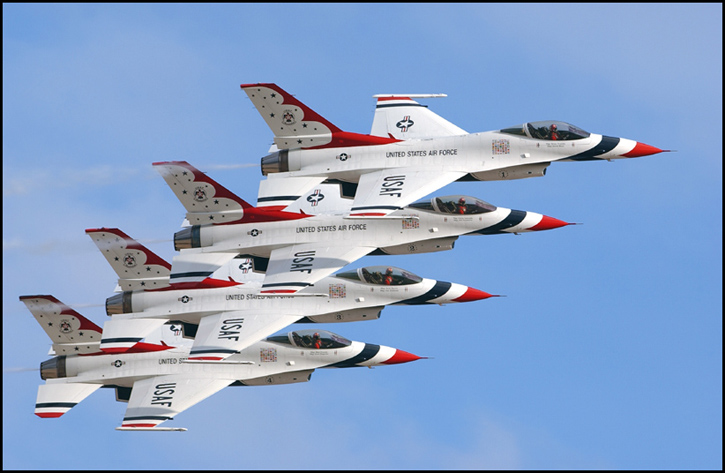Fighter Jet News
F-16 Fighting Falcon News
The making of a Thunderbird jet
September 15, 2004 (by
Staff Sgt Kati Garcia) -
It takes less than 72 hours to convert a red, white and blue Thunderbird F-16 back to combat status. But what about taking a combat-ready aircraft and making it "Thunder-ready?"
That's exactly what the men and women of the U.S. Air Force Air Demonstration Squadron, the Thunderbirds, demonstrated recently.
The five-month long endeavor to turn a "gray-world" jet red, white and blue began when the Ready Reserve Fleet of the Arkansas Air National Guard turned over one of their F-16Cs to the Thunderbirds.
"We spent a week inspecting the aircraft and ensuring it was ready for flight," said Senior Airman Danicka Smith, aircraft 86-0281's dedicated crew chief. Airman Smith is one of the Thunderbirds' 22 showline members.
When picking the team of maintainers responsible for the aircraft's transformation, Thunderbird maintenance officer Capt. Dave Moreland had the task of hand-picking a team from an already hand-picked team.
"Nine hundred man-hours went into working on this aircraft prior to the first coat of paint being applied," Captain Moreland said. "We needed maintainers who knew that airframe inside and out -- we relied heavily on the corporate knowledge within this hangar."
The 18-year old aircraft was a fully operational F-16, complete with weapons stations, pylons and tanks -- none of which the Thunderbirds team uses on its demonstration aircraft.
"People with more than 15 different [Air Force Specialty Codes] fine-tuned this aircraft, going above and beyond to meet the deadline we had set," Captain Moreland said.
That deadline was set early on, and from the start, Captain Moreland said his team exceeded his expectations.
"The book gives us 14 days for the transfer inspection -- they covered tip to tail in six," he said.
Maj. Brian Burns was the first to fly the aircraft in a show.
"When I flew in it the first time, I couldn't tell a difference between it and any of our other jets," Major Burns said. "That's just a testament to how well all of the maintainers here did getting the jet ready to go for the Moffett, Calif. show."
While the man-hours that went into converting the aircraft are priceless, the depot modifications alone carry a $300,000 price tag.
According to Captain Moreland, the gun system and ammunition drum have to be removed to make room for the smoke oil system that delivers the white smoke seen in the shows. The smoke system and the paint are the two main differences. But the work that goes into making a jet Thunderbird material is something entirely different.
"The tireless dedication I witness in this hangar on a daily basis never ceases to amaze me," Captain Moreland said.
Photogalleries:
The five-month long endeavor to turn a "gray-world" jet red, white and blue began when the Ready Reserve Fleet of the Arkansas Air National Guard turned over one of their F-16Cs to the Thunderbirds.
"We spent a week inspecting the aircraft and ensuring it was ready for flight," said Senior Airman Danicka Smith, aircraft 86-0281's dedicated crew chief. Airman Smith is one of the Thunderbirds' 22 showline members.
When picking the team of maintainers responsible for the aircraft's transformation, Thunderbird maintenance officer Capt. Dave Moreland had the task of hand-picking a team from an already hand-picked team.
"Nine hundred man-hours went into working on this aircraft prior to the first coat of paint being applied," Captain Moreland said. "We needed maintainers who knew that airframe inside and out -- we relied heavily on the corporate knowledge within this hangar."
The 18-year old aircraft was a fully operational F-16, complete with weapons stations, pylons and tanks -- none of which the Thunderbirds team uses on its demonstration aircraft.
"People with more than 15 different [Air Force Specialty Codes] fine-tuned this aircraft, going above and beyond to meet the deadline we had set," Captain Moreland said.
That deadline was set early on, and from the start, Captain Moreland said his team exceeded his expectations.
"The book gives us 14 days for the transfer inspection -- they covered tip to tail in six," he said.
Maj. Brian Burns was the first to fly the aircraft in a show.
"When I flew in it the first time, I couldn't tell a difference between it and any of our other jets," Major Burns said. "That's just a testament to how well all of the maintainers here did getting the jet ready to go for the Moffett, Calif. show."
While the man-hours that went into converting the aircraft are priceless, the depot modifications alone carry a $300,000 price tag.
According to Captain Moreland, the gun system and ammunition drum have to be removed to make room for the smoke oil system that delivers the white smoke seen in the shows. The smoke system and the paint are the two main differences. But the work that goes into making a jet Thunderbird material is something entirely different.
"The tireless dedication I witness in this hangar on a daily basis never ceases to amaze me," Captain Moreland said.
Photogalleries:
- Thunderbirds walkaround - Dover, 5/16/2004
- Thunderbirds demo team
Courtesy of U.S. Air Force Air Demonstration Squadron Public Affairs

